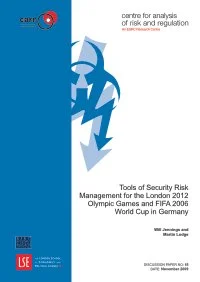Blowe, Kevin and du Boulay, Estelle
In the months before the start of the 2012 Olympics in Stratford in east London, there was a growing anxiety amongst Londoners about the prospect of snipers in helicopters and RAF fighters in the skies, missile launchers on tower blocks and repeated predictions that Newham would experience lockdown during peak periods. Newham Monitoring Project had also been receiving enquiries from across east London for months from local residents, particularly those working with young people, who were concerned about the massive proposed policing operation and its impact at street level. London 2012 seemed to deserve its reputation as the first 'Security Games'. The Olympics presented the largest peacetime military and security operation since 1945, with a policing and security budget of around L553m. From 2010, the number of security personnel required by Olympic organisers rose sharply to an estimated 23,700 on the busiest days, more than double the original predictions, with up to 12,000 police from forces across the country and the Ministry of Defence providing more troops deployed (in uniform) to work during the Games than were then stationed in Afghanistan. Even more CCTV was installed in a city that already had the highest level of surveillance of its citizens than anywhere in the world, whilst around $80 million was spent on the construction of an 11-mile long 5000-volt electric fence around the Olympic zone. The reason for this extraordinary level of security, the Home Office argued in its March 2011 publication 'Olympic and Paralympic Safety and Security Strategy,' was primarily the threat from terrorism: it promised 'maximum use of existing national security and intelligence structures' with the threat-level raised from 'substantial' to 'severe' (which assumes 'an attack is highly likely'). A secondary threat was public disorder, heightened by the perception of a weak police response to rioting the previous summer that followed the death of Mark Duggan in August 2011. The International Olympic Committee had made it clear after the riots that it expected the British government, the Metropolitan police and other domestic agencies to ensure that the Olympics passed off without incident. Arrangements were made to fast-track the trials of people accused of offences linked to the Olympics in the same highly controversial way that had followed the disorder of the previous year, with Alison Saunders, the chief CPS prosecutor for London, explicitly linking these measures to 'the lessons of the summer riots.' With a climate of fear slowly building through state institutions and the media, we were also aware of the significant pattern of racialised social "sanitisation" and exploitation that have been a hallmark of sport mega events globally, particularly where they have been held in poorer and developing areas. Activists and academics from countries including South Africa and India, which have both hosted major sport events in recent years, travelled to the UK to share their experiences of human rights abuses and 'sweep up operations' in their localities. These had had a massively detrimental and often devastating impact on the lives of local people, leaving them homeless, unemployed or vulnerable to excessive policing or criminalisation, with a legacy of property developers and real estate owners benefiting most. These were real life stories behind the promises of employment and regeneration that had been made in each host city. We recognised that an atmosphere of intensive security, focused on the borough where Newham Monitoring Project has worked for over thirty years, had the potential to negatively impact on local people. Most military and all private security personnel would work inside the 'ticketed areas' of the event venues, but in the streets surrounding the Olympic Park in Stratford and the ExCel Centre in Canning Town, it was the prospect of a massive policing operation that was our greatest concern. Newham is one of London's poorest and most ethnically diverse boroughs with the second highest Muslim population in the UK, one that had experienced long-term state surveillance, suspicion and incidents like the bungled anti-terrorism raids in 2006 on two families living in Forest Gate, who endured a terrifying ordeal based on faulty intelligence. The borough also has one of the youngest populations in London, with 23.6% of residents in 2011 aged between 10 and 24,6 coupled with a long history of difficult relationships between young people and the police. This is particularly the case over the use of stop and search powers.
London: Newham Monitoring Project, 2013. 29p.









